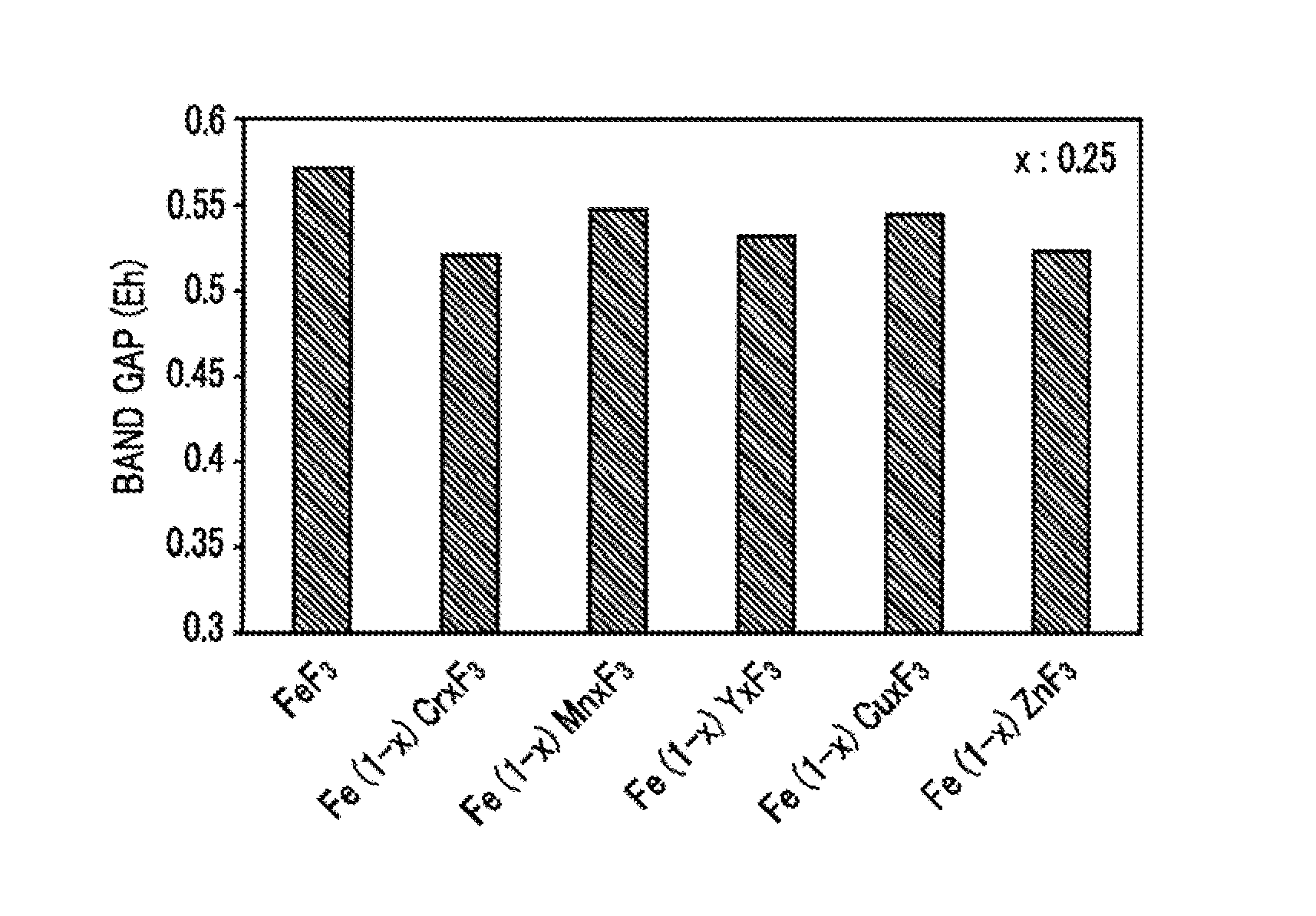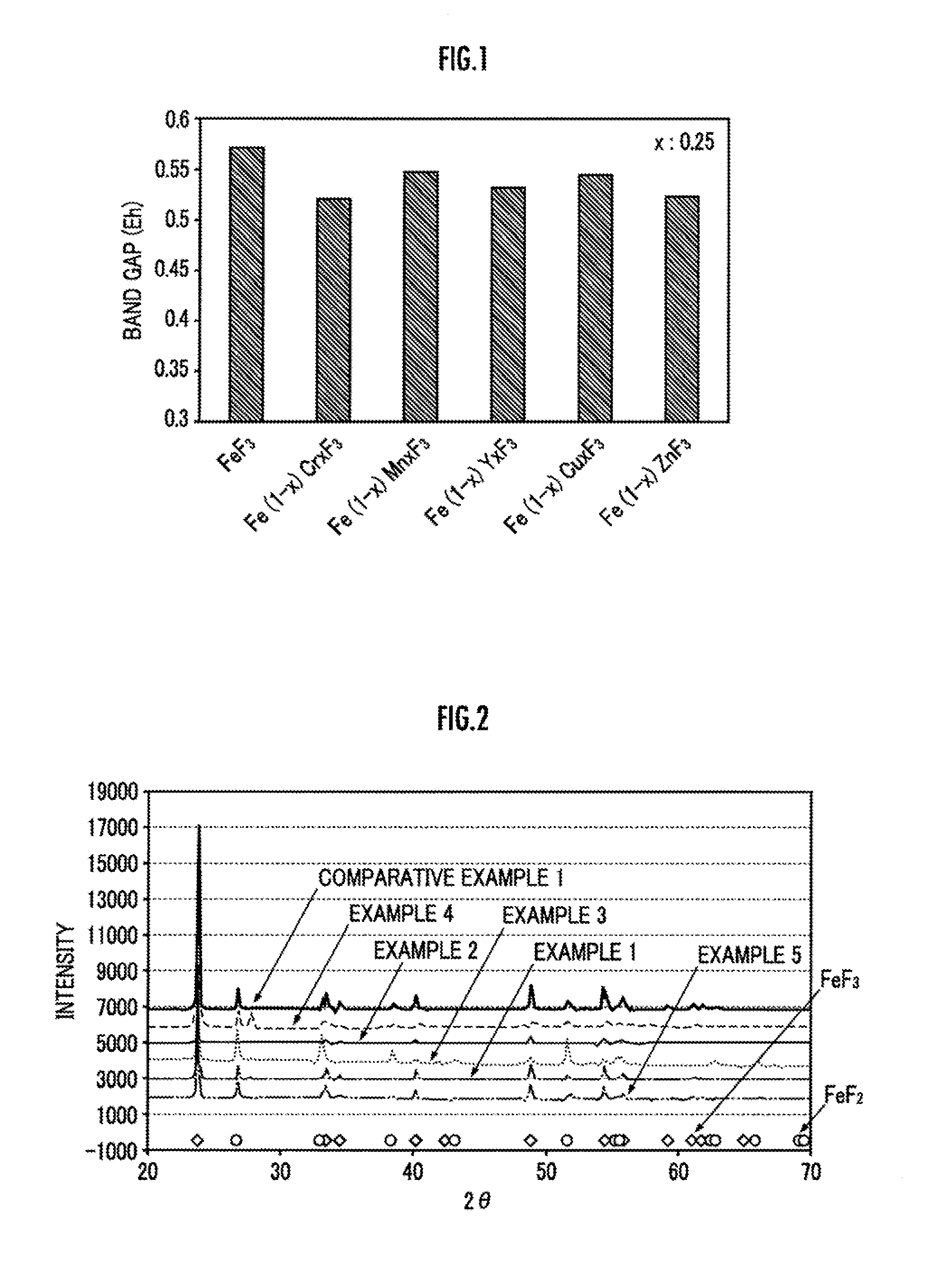Cathode active material
a technology of active materials and cathode, which is applied in the direction of conductors, cell components, transportation and packaging, etc., can solve the problems of insufficient effect of reducing the band gap of mixed metal fluoride, and achieve excellent charge and discharge properties, reduce the band gap of mixed metal fluoride, and stably exist
- Summary
- Abstract
- Description
- Claims
- Application Information
AI Technical Summary
Benefits of technology
Problems solved by technology
Method used
Image
Examples
example 1
[0028]In this example, iron nitrate and manganese nitrate, with the manganese ion content set to 5% by mass based on the mass of iron ions, were dissolved in a mixed solvent containing water and 25% by mass of ethanol to prepare a first solution. The total concentration of iron nitrate and manganese nitrate was 0.05 mol / l based on the mixed solvent. Then, each of ammonium hydrogen fluoride and ethylene glycol was dissolved at 20% by mass in water to prepare a second solution.
[0029]Then, 210 g of the first solution was slowly added dropwise to 120 g of the second solution to allow reaction to occur. After dropwise addition of the first solution was completed, the reaction solution was stirred for 3 hours and the precipitate was filtered under reduced pressure to provide a product. The resulting product was again dispersed in an ethanol solution and filtered under reduced pressure to wash and remove ethylene glycol contained in the product.
[0030]The resulting product was dried under r...
example 2
[0039]The powder of the mixed metal fluoride represented by the chemical formula Fe0.99Cu0.01F3 was obtained just as in Example 1 except that copper nitrate was used in place of manganese nitrate, with the copper ion content set to 5% by mass based on the mass of iron ions. Table 1 shows the metal by which a part of Fe was substituted and the value of x for the mixed metal fluoride obtained in this example.
[0040]Next, the crystalline structure of the powder of Fe0.99Cu0.01F3 was examined by X-ray diffraction. The result is shown in FIG. 2. It is clear from FIG. 2 that the powder of Fe0.99Cu0.01F3 obtained in this example has a crystalline structure in which a part of Fe in FeF3 having a perovskite structure has been substituted by Cu.
[0041]Then, a non-aqueous electrolyte secondary battery was produced using Fe0.99Cu0.01F3 as a cathode active material just as in Example 1 except that the powder of Fe0.99Cu0.01F3 obtained in this example was used.
[0042]Subsequently, charge and dischar...
example 3
[0043]The powder of the mixed metal fluoride represented by the chemical formula Fe0.99Zn0.01F3 was obtained just as in Example 1 except that zinc nitrate was used in place of manganese nitrate, with the zinc ion content set to 5% by mass based on the mass of iron ions. Table 1 shows the metal by which a part of Fe was substituted and the value of x for the mixed metal fluoride obtained in this example.
[0044]Next, the crystalline structure of the powder of Fe0.99Zn0.01F3 obtained in this example was examined by X-ray diffraction. The result is shown in FIG. 2. It is clear from FIG. 2 that the powder of Fe0.99Zn0.01F3 obtained in this example has a crystalline structure in which a part of Fe in FeF3 having a perovskite structure has been substituted by Zn.
[0045]Then, a non-aqueous electrolyte secondary battery was produced using Fe0.99Zn0.01F3 as a cathode active material just as in Example 1 except that the powder of Fe0.99Zn0.01F3 obtained in this example was used.
[0046]Subsequentl...
PUM
| Property | Measurement | Unit |
|---|---|---|
| temperature | aaaaa | aaaaa |
| temperature | aaaaa | aaaaa |
| temperature | aaaaa | aaaaa |
Abstract
Description
Claims
Application Information
 Login to View More
Login to View More - R&D
- Intellectual Property
- Life Sciences
- Materials
- Tech Scout
- Unparalleled Data Quality
- Higher Quality Content
- 60% Fewer Hallucinations
Browse by: Latest US Patents, China's latest patents, Technical Efficacy Thesaurus, Application Domain, Technology Topic, Popular Technical Reports.
© 2025 PatSnap. All rights reserved.Legal|Privacy policy|Modern Slavery Act Transparency Statement|Sitemap|About US| Contact US: help@patsnap.com



